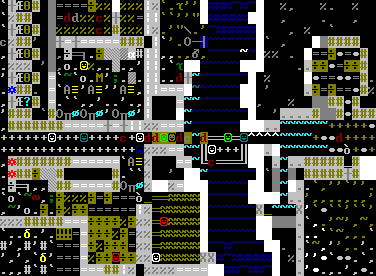Essay Sketch
In order to express the concepts learned in class, I will be using a genre of terminal games
known as roguelikes as a metaphor. The game first game to define the genre,
Rogue, and its successors
have been very influential in my life. I’ve played them for years and I use them as inspiration for my own creative works.
In the Garden of Forking Paths, Dr. Tsun learns that for every action, all possible alternatives occur. Not only do roguelikes take place in a literal labyrinths, they also focus on the same concept of choice. The objective of Rogue is to traverse a labyrinth full of dangers in order to reach the bottom floor. Time in the labyrinth stays still until the player does an action. Once the player makes takes a turn, so do the other units in the world. On the chance that the player dies, the player starts again from the beginning in a different labyrinth.
For this essay sketch, each node is represented by a room in the style of a roguelike. In the room you can navigate with the arrow keys and interact with objects with enter. The objects are my links to lexia and it's up to the player to determine what they want to see and when. Like hypertext, one can freely move from page to page, stepping on an arrow.
In the Garden of Forking Paths, Dr. Tsun learns that for every action, all possible alternatives occur. Not only do roguelikes take place in a literal labyrinths, they also focus on the same concept of choice. The objective of Rogue is to traverse a labyrinth full of dangers in order to reach the bottom floor. Time in the labyrinth stays still until the player does an action. Once the player makes takes a turn, so do the other units in the world. On the chance that the player dies, the player starts again from the beginning in a different labyrinth.
For this essay sketch, each node is represented by a room in the style of a roguelike. In the room you can navigate with the arrow keys and interact with objects with enter. The objects are my links to lexia and it's up to the player to determine what they want to see and when. Like hypertext, one can freely move from page to page, stepping on an arrow.
Controls

Move

Interact
Press Enter to Start




